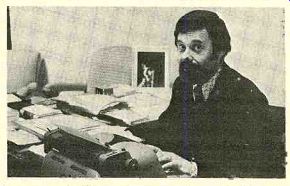
by MARTIN BOOKSPAN
GERSHWIN'S RHAPSODY IN BLUE
IF the Fourth of July, 1776, marks the start of I American independence, then the 1924 anniversary of Abraham Lincoln's birthday, February 12, might well be considered the start of the independence of American con cert music. It was on that date, near the end of a very long program given in New York's Aeolian Hall by Paul Whiteman and His Orchestra, that the Rhapsody in Blue by George Gershwin was given its first performance. The significance of the event was not lost on some in that first audience. Carl Van Vechten, the distinguished novelist and writer about music, wrote to Gershwin after the concert: "Quite as a matter of course the concert was a riot; you crowned it with what I am forced to regard as the foremost serious effort by an American composer." These words have about them the ring of prophecy. For in the Rhapsody in Blue Gersh win quite spontaneously and innocently created a whole new concert vocabulary for the American composer, one that literally changed everything. The Rhapsody in Blue was the musical shot that was heard round the world. All at once the rhythms and tempo of American life became translated into a musical expression instantly recognizable as uniquely and unmistakably American. No more influential work had ever before been written by an American composer, and there has been nothing in the half-century since the Rhapsody that has had anything like its effect on American concert music.
When the year 1924 dawned, Gershwin was an enormously successful composer of pop tunes and Broadway shows, a twenty-five year-old at the full flood of his bursting genius. The circumstances of the creation of the Rhapsody in Blue were so casual as to be ludicrous. Whiteman had asked Gershwin to write something for him for the Lincoln's Birthday concert; Gershwin had said "Sure," and then promptly forgot about it. It was only when an announcement about the concert appeared in the paper, promising a new work by George Gershwin, that he was reminded of his commitment to Whiteman. This was in early January, and Gershwin was putting the finishing touches on his score for the Broad way-bound musical Sweet Little Devil. The plan and substance for the Rhapsody in Blue came to him on a train ride between New York and Boston, where Sweet Little Devil was in its tryout run. "I heard it as a sort of musical kaleidoscope of America," Gershwin wrote, "of our vast melting-pot, of our in comparable national pep, our blues, our metropolitan madness." Since time was so short before the scheduled concert, Gershwin and Whiteman agreed that a piano score would suffice: the details of the orchestration would be tended to by arranger Ferde Grofe.
For that first performance, Grofe naturally arranged the Rhapsody specifically for the Whiteman Band. Later came Grofe's scoring for piano solo and symphony orchestra, the setting in which we usually hear the music to day. But there is something that seems right about the scoring for piano and band, which lends the music its most natural sound and expression. Fortunately, an excellent performance and recording of the Rhapsody in this form exists-Eugene List's, with Samuel Adler conducting the Berlin Symphony Orchestra (Turnabout TVS 34457). Included also are List performances of the three Gershwin Preludes for Piano and a List-Adler collaboration on the Gershwin Piano Concerto. All the works receive splendidly idiomatic treatment.
OF the piano-with-symphony-orchestra recordings, my choices remain those by Leonard Bernstein (Columbia M 31804, cartridge MA 31804, cassette MT 31804) and Earl Wild with Arthur Fiedler and the Boston Pops (RCA LSC 2367, included on cartridge CRS2-0783 and cassette CRK2-0783). Bernstein plays and conducts the performance from the keyboard-as he has been doing with the New York Philharmonic on its recent tour in this country and abroad. The recorded performance has its excesses, to be sure, but the conviction and commitment of the playing sweep aside any criticisms as far as I am concerned.
The Wild-Fiedler collaboration plays the mu sic straighter, but it is tremendously effective and joyously exuberant nonetheless.
The 1976 UPDATING OF THE BASIC REPERTOIRE is now available in convenient pamphlet form. Send 250 and a stamped, self-addressed No. 10 envelope (9 1/2 x 4 1/2 in.) to Esther Maldonado, Stereo Review, 1 Park Avenue, New York, N.Y. 10016 for your copy.
Also see:
TECHNICAL TALK, JULIAN D. HIRSCH
AUDIO BASICS--The New London Cassettes, RALPH HODGES